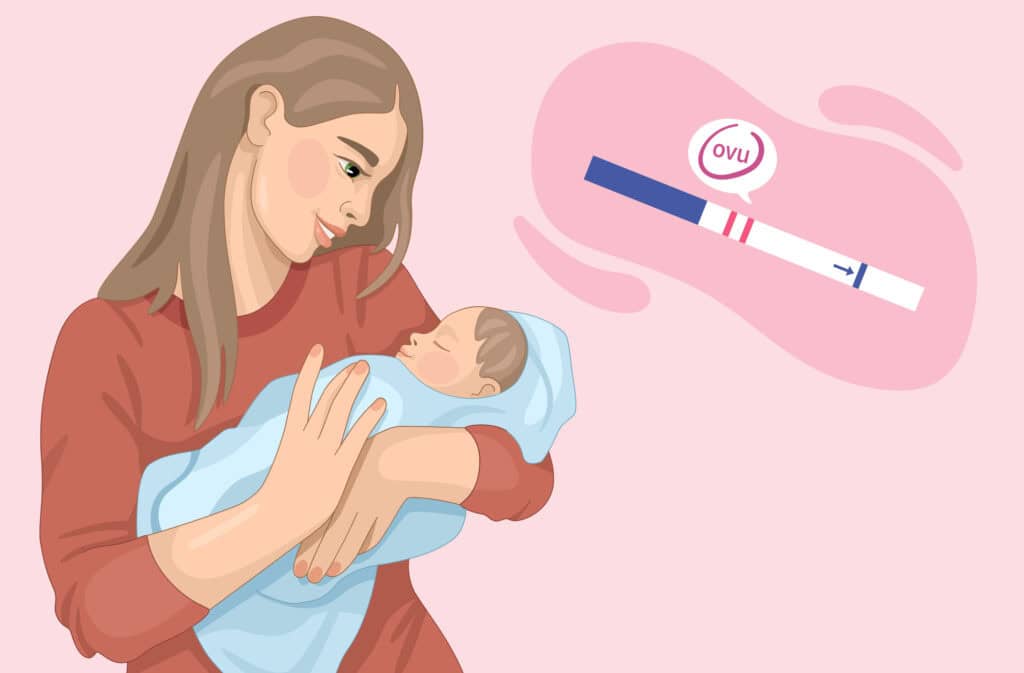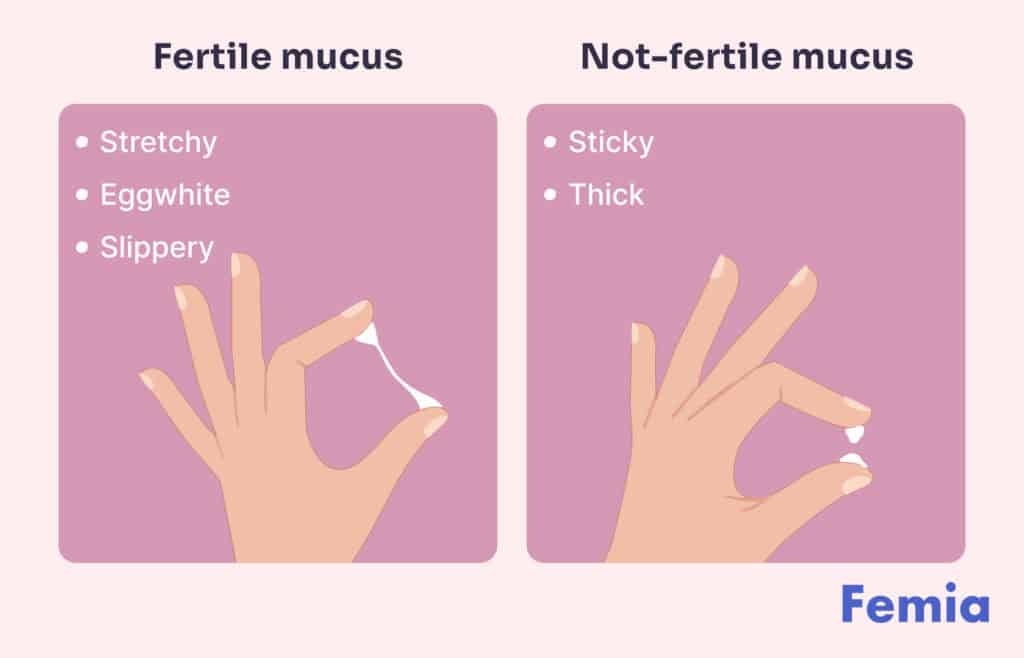Femia > Health Library > Being a mom > Recovering from birth > Signs of ovulation after giving birth: What new moms need to know
Signs of ovulation after giving birth: What new moms need to know

- Updated Feb 11, 2025
- Published
CRAFTED BY HUMAN
Crafted by human At Femia, we provide accurate and up-to-date information at every stage of your journey, from trying to conceive, pregnancy and postnatal support. All content is created by a real person based on in-depth research and own professional experience. Femia ensures that you will receive expert advice, strict accuracy and a personalized approach from our authors/medical experts. Learn more about our editorial policy.
FACT CHECKED
Fact checked At Femia Health, we maintain the highest standards of editorial excellence in delivering content focused on helping you conceive, guiding you through pregnancy, and supporting you postpartum. Explore our content review principles to learn how we ensure the accuracy and quality of our health and lifestyle tips for every stage of your journey.
When fertility returns after giving birth can vary greatly from woman to woman. Some women will ovulate only a few weeks after giving birth, whilst for others it can take over a year. Breastfeeding can delay the time it takes for ovulation to return. Ovulation can also occur before you have your first period, so tracking ovulation symptoms like cervical mucus and urinary LH levels can help you to identify when you are fertile again.
For the last nine months, ovulation has been on hold while your body has been growing your baby. But, now that your little one has arrived, you might be wondering when you can expect your fertility to return.
For some women, the idea of getting pregnant again soon after giving birth is the furthest thing from their minds, and they want to know the best way to prevent this from happening. Others are hoping for a small age gap between siblings and are wondering when they can start trying to conceive (TTC) again.
While every family is different, understanding when your fertility may return can help you plan for the future you want.
When thinking about fertility after giving birth, several factors need to be taken into consideration. After giving birth, your body undergoes several physical and hormonal changes as it adjusts to the postpartum period, and some of these will affect when your fertility returns. In particular, how you choose to feed your baby will affect when ovulation might return.
So, whether you’re looking to avoid pregnancy or want to know when you might successfully be able to TTC, then read on to discover everything you need to know about ovulation and fertility after giving birth.
Femia offers the most accurate tool for determining ovulation and fertile days
Signs of ovulation after giving birth
During pregnancy, your menstrual cycle is suspended, and you do not ovulate or have a period. After giving birth, your menstrual cycle should resume and your fertility return; however, exactly when this happens can vary widely.
@femia.fertility Your body always knows when you're ovulating—you just need to tune in and listen. We're here to help you understand those signals. Click the link in our bio and join us! #ovulation #ovulationsymptoms #ttccommunity #fertilityawareness #ttc #fertilitytracker #highfertility #learnontiktok #periodtok #ovulationsign ♬ original sound - Femia fertility tracker
How soon can ovulation return after giving birth?
The American College of Obstetricians and Gynecologists states that for those who are not breastfeeding, “ovulation may occur within a few weeks of childbirth.” And, once ovulation has started again, it is possible to get pregnant. According to the ACOG, ovulation can be delayed for longer if you are breastfeeding but will typically return by about six months.
Other leading health organizations such as the WHO advise that you can get pregnant again as little as 45 days after giving birth, and ovulation can happen even before the first menstruation. So, not having had a period yet does not mean that you can’t get pregnant.
A 2011 literature review looked at several previous studies that evaluated how long it took for a woman to ovulate for the first time after giving birth. It found that for women who are not lactating (producing breastmilk), it took an average of 45–94 days after giving birth for them to ovulate for the first time. However, another study found that ovulation could occur as little as 24 days after giving birth.
👉Find out more: Ten signs of pregnancy while breastfeeding
Signs of ovulation
Whether it takes weeks or months for your fertility to return, several common signs can indicate that you are about to ovulate:
Cervical mucus. The color, consistency, and amount of cervical mucus you produce varies throughout the menstrual cycle. One study found that as you approach ovulation, the amount of mucus produced increases, and the color becomes cloudy. Immediately before ovulation, when you’re most fertile, the cervical mucus becomes clear, stretchy, and slippery, like egg whites.
Ovulation pain. Some women experience temporary pain when they ovulate. This pain is one-sided and can change sides each cycle, depending on which ovary is releasing the egg. It can be a dull pain or sharp twinge and last anywhere from a few minutes to one to two days. It occurs roughly 14 days before the start of the next period and is sometimes accompanied by a small amount of vaginal bleeding.
Basal body temperature (BBT). The basal body temperature is the temperature of your body first thing in the morning when you’re at total rest. For decades, women have tracked their BBT as a way of predicting ovulation: your BBT is normally consistent throughout the menstrual cycle, but just before ovulation occurs it will drop slightly, then increase significantly just after the egg is released. By tracking this fall and rise, some women can predict ovulation. However, a review article in 2005 found that the majority of research shows that BBT is not a reliable marker of ovulation.
Urinary luteinizing hormone (LH). Around 24–36 hours before you ovulate, your body releases a surge of LH. This surge can be detected in your urine using at-home ovulation predictor kits. A 2015 Cochrane review looked at studies that had evaluated the effectiveness of monitoring urinary LH levels and found that couples using this technique to time sex had a higher chance of getting pregnant. However, a second article reviewing the literature noted that several studies found that not all LH surges are followed by ovulation. So, whilst monitoring urinary LH can increase the chances of getting pregnant for some couples, it is not useful for everyone.
No single method is a 100% accurate predictor—every body is unique and reacts to ovulation differently, so what works for another woman might not work for you. Thus, it is recommended to use a combination of methods. Paying attention to the possible ovulation symptoms you experience and using a period-tracking app like Femia to record and track them can help increase your chances of predicting ovulation.
👉Find out more: Understanding ovulation symptoms: Mood changes explained

Signs of returning fertility while breastfeeding
Does breastfeeding impact fertility?
Exclusively breastfeeding, where you only give your baby breastmilk, can delay the return of ovulation. When you breastfeed, your body produces the hormone prolactin, which stops the brain from making and releasing the reproductive hormone LH. In turn, this stops the ovaries from developing and releasing eggs, inhibiting ovulation. There is a form of natural contraception called the lactational amenorrhea method (LAM) that relies on the inhibition of ovulation during breastfeeding to prevent pregnancy in the first six months.
A group of experts in 1995 determined that if you use LAM correctly, your risk of getting pregnant if you are exclusively breastfeeding is less than 2% in the first six months. However, many health institutions still advise the use of additional contraception even if you are breastfeeding, because the effectiveness of LAM can vary greatly.
Typical timelines
According to ACOG, ovulation typically returns by six months for breastfeeding women. However, it can vary widely, and some women will find their fertility returns much earlier or later. One study found that the length of time it took for ovulation to return varied from 24 days after giving birth to 750 days.
A change in breastfeeding frequency due to your baby sleeping through the night, the introduction of formula or solid foods, or pumping can all trigger fertility to restart. It is also possible to ovulate before your periods have restarted, so looking out for signs of ovulation—especially if you have recently reduced the frequency of breastfeeding—can help you to identify when you might be fertile again.
Femia offers the most accurate tool for determining ovulation and fertile days
Are you more fertile after having a baby?
There are two different ways that this question can be interpreted, and each gives a different answer.
If you interpret the question as “Does giving birth make you more fertile?”, then the answer is “no.” There is no evidence to suggest that you will be extra fertile after giving birth; however, according to several health institutes like ACOG and the NHS, your fertility can return as little as three weeks after giving birth.
On the other hand, if you interpret the question as “Does having a baby increase my chances of being able to get pregnant again?”, then the answer is “yes.” If you have already had a baby, then you are less likely to suffer from infertility if you try to get pregnant again. However, secondary infertility can still occur; this is often linked to increasing age.
If you have any concerns about your fertility after giving birth or would like advice on the best way for you to conceive again (or not), then speak to your healthcare provider. They will be able to give you personalized advice.
Questions from the Femia community
Can you get pregnant before your first postpartum period?
Yes, it is possible to ovulate and become pregnant before having your first postpartum period. One study found that depending on when fertility returns, anywhere from 33% to 87% of women will ovulate before they have their first period.
How can I track ovulation postpartum?
If you want to track your ovulation postpartum, then it is important to look out for the signs that suggest ovulation is about to happen or has just happened.
Monitoring your cervical mucus, tracking your basal body temperature, using ovulation predictor kits, or using an ovulation tracking app like Femia can all help you predict when ovulation will occur.
Is it safe to use birth control while breastfeeding?
After giving birth, it is important to discuss the use of birth control with your healthcare provider. Several forms of birth control, like the mini pill, are safe to use whilst breastfeeding even straight after giving birth. Your healthcare provider will be able to help you decide on the best option for you.
What if my period hasn’t returned after a year of breastfeeding?
It can be normal for your period to not return when you are breastfeeding, even if it has been a year. However, it is always better to discuss any concerns that you might have with your healthcare provider, who will be able to give you personalized advice.
Can I use natural family planning methods postpartum?
Natural family planning methods, such as LAM, can be used after birth, but it is not a suitable method for all women. It is also important to remember that several factors like fluctuating hormone levels can make them less reliable than typical contraception. If you wish to consider using a natural family planning method as contraception postpartum, then you should discuss this first with your healthcare provider.
The bottom line
When your fertility will return after giving birth can vary widely. Some women will start to ovulate as little as a few weeks after giving birth, whilst it will take others over 12 months. If you are not breastfeeding, it will likely return sooner than if you are.
It is common to ovulate before you have had your first period, which means you could be fertile again before you even know that your menstrual cycle has restarted. Understanding the signs of ovulation can help you to predict when you might be fertile again, even if you haven’t had a period yet. A change in cervical mucus, basal body temperature, or urinary LH levels can all indicate that ovulation might be about to occur.
For a more personalized approach, or if you have any concerns about getting pregnant again after giving birth, then it is important to discuss signs of ovulation and birth control options with your healthcare provider. They will be able to help you make the best decisions for yourself and your family.
References
- Barron, Mary Lee, and Richard Fehring. “Basal Body Temperature Assessment: Is It Useful to Couples Seeking Pregnancy?” MCN, the American Journal of Maternal Child Nursing, vol. 30, no. 5, Sept. 2005, pp. 297–98. https://doi.org/10.1097/00005721-200509000-00005.
- Benksim, Abdelhafid, et al. “Difference Between Primary and Secondary Infertility in Morocco: Frequencies and Associated Factors.” PubMed, vol. 12, no. 2, July 2018, pp. 142–46. https://doi.org/10.22074/ijfs.2018.5188.
- Billings, E. L., et al. “SYMPTOMS AND HORMONAL CHANGES ACCOMPANYING OVULATION.” Lancet, vol. 299, no. 7745, Feb. 1972, pp. 282–84. https://doi.org/10.1016/s0140-6736(72)90291-7.
- Jackson, Emily, and Anna Glasier. “Return of Ovulation and Menses in Postpartum Nonlactating Women.” Obstetrics and Gynecology (New York. 1953. Online)/Obstetrics and Gynecology, vol. 117, no. 3, Mar. 2011, pp. 657–62. https://doi.org/10.1097/aog.0b013e31820ce18c.
- Kennedy, et al. “Lactational Amenorrhea Method for Family Planning.” International Journal of Gynecology and Obstetrics, vol. 54, 1996, pp. 55–57. https://doi.org/10.1016/0020-7292(96)02670-7.
- Lactational Amenorrhea Method – USMEC | CDC. www.cdc.gov/reproductivehealth/contraception/mmwr/mec/appendixg.html.
- Lewis, Patricia R., et al. “The Resumption of Ovulation and Menstruation in a Well-nourished Population of Women Breastfeeding for an Extended Period of Time.” Fertility and Sterility, vol. 55, no. 3, Mar. 1991, pp. 529–36. https://doi.org/10.1016/s0015-0282(16)54180-6.
- Manders, Marlies, et al. “Timed Intercourse for Couples Trying to Conceive.” Cochrane Library, Mar. 2015, https://doi.org/10.1002/14651858.cd011345.pub2.
- “Postpartum Birth Control.” ACOG, www.acog.org/womens-health/faqs/postpartum-birth-control.
- Su, Hsiu‐Wei, et al. “Detection of Ovulation, a Review of Currently Available Methods.” Bioengineering & Translational Medicine, vol. 2, no. 3, May 2017, pp. 238–46. https://doi.org/10.1002/btm2.10058.
- Website, Nhs. “Sex And Contraception After Birth.” nhs.uk, 11 Mar. 2024, www.nhs.uk/conditions/baby/support-and-services/sex-and-contraception-after-birth.
- World Health Organization, et al. Programming Strategies for Postpartum Family Planning. 2013, iris.who.int/bitstream/handle/10665/93680/9789241506496_eng.pdf.

Explore the symptoms at 15 days past ovulation (15 DPO), your body changes, and learn how to confirm your pregnancy with accurate testing. Expert advice from Femia.

Why does masturbation matter for women and how can you do it to achieve pleasure? Click to find a comprehensive female masturbation tutorial for self-exploration.

Luteinizing hormone (LH) triggers ovulation within 24-36 hours of LH peak. Find out how long after an LH surge do you ovulate to boost your chance of conceiving.

